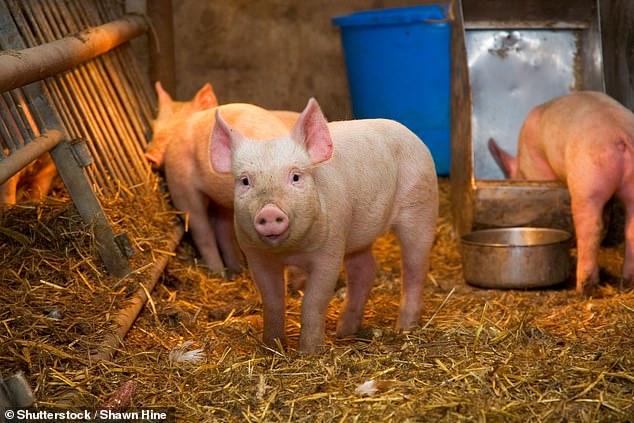Health chiefs STILL don’t know how elderly Brit caught swine flu in freak incident involving never-before-seen strain that experts fear could be spreading under the radar
Health officials today admitted they still have no idea how an elderly Briton came down with swine flu never seen here before.
The unidentified patient, now known to be aged over 75 and from North Yorkshire, had a 'mild' illness and made a full recovery at home.
The disease was only discovered by chance when they were randomly tested by their GP, raising fears that the H1N2 virus was spreading under the radar.
Bosses at the UK Health Security Agency (UKHSA) have yet to detect any more cases as they battle to contain a possible outbreak.
But she admitted that 'a limited degree' of human-to-human transmission 'may have occurred'.
The unidentified patient, now known to be aged over 75 and from North Yorkshire, had a 'mild' illness and made a full recovery at home. The disease was only discovered by chance when they were randomly tested by their GP, sparking fears that the H1N2 virus was spreading under the radar

The symptoms of swine flu – which caused a pandemic that swept around the world in 2009 – mirror those of the regular flu and Covid. But it does not spread easily between people. Most cases occur in people exposed to infected pigs, such as fairground visitors and farmers. The number of cases of swine flu increases in pigs in the autumn and winter
Officials revealed that one household contact and one other contact of the patient “were symptomatic.”
But their symptoms had already disappeared when they were identified and they were not tested even though they felt unwell.
The infected Briton visited the doctor on November 9 and received the laboratory results two weeks later, on November 23.
The UKHSA is still doing 'rapid work' to identify how the virus was acquired.
The Brit did not work with pigs and 'no direct contact' between the patient and 'any animal' was reported.
“The presence of a symptomatic household contact means that limited human-to-human transmission may have occurred,” they said.
Meera Chand, incident director at UKHSA, added: 'This is the first time we have detected this virus in people in Britain.
'Since the confirmation of the virus, we have worked quickly to learn more about it and how it may have been acquired.
'Research to date has not identified any further human cases and sporadic cases of influenza due to swine viruses are known to occur.'
Britons have a 'very low risk of exposure to this virus in pigs', officials also warned.
However, those who are regularly exposed directly to pigs may be at 'higher risk'.
The regions of East Anglia, Yorkshire – where the unidentified patient lives – and the Humber regions all have the highest pig densities and a a high percentage of commercially farmed pigs compared to the rest of Britain, she added.
The symptoms of swine flu are similar to those of the regular flu and Covid. But it does not spread easily between people.
Most cases occur in people exposed to infected pigs, such as fairground visitors and farmers. The number of cases of swine flu increases in pigs in the autumn and winter.
Deaths are rare and the disease usually clears up within a few weeks.
Since 2005, only 50 human cases of H1N2 have been reported worldwide.
But none of them have been to Britain. Nor is there one genetically related to this particular species.
In 2009, a swine flu pandemic emerged after a mutated version of H1N1 spread to humans.
That variant, scientifically known as H1N1(pdm09), contained genetic material from viruses circulating in pigs, birds and humans.
A independent assessment of the British response The 2009 pandemic revealed that 457 deaths were caused by swine flu in the country.
But the strain, which has killed tens of thousands of people across the planet, has barely spread in Britain since 2019. The disease now circulates seasonally among humans.
The mortality rate – the percentage of patients who died from the disease – was estimated at about 0.02 percent. By comparison, when Covid first hit, it had a mortality rate of up to three percent.
Seasonal flu vaccines do not protect against swine flu. But certain groups, including children and pregnant women, are eligible for a shot specific to the virus.
According to the winter surveillance program, only a fraction of patients who visit their GP with respiratory complaints, such as a runny nose and cough, are ever tested.
It covers just less than a third of the more than 6,700 operations in England and Wales.
Some patients suspected of having a respiratory virus, such as the flu, have a nasal swab taken. Laboratory analyzes of smears often take an average of about 10 days.
